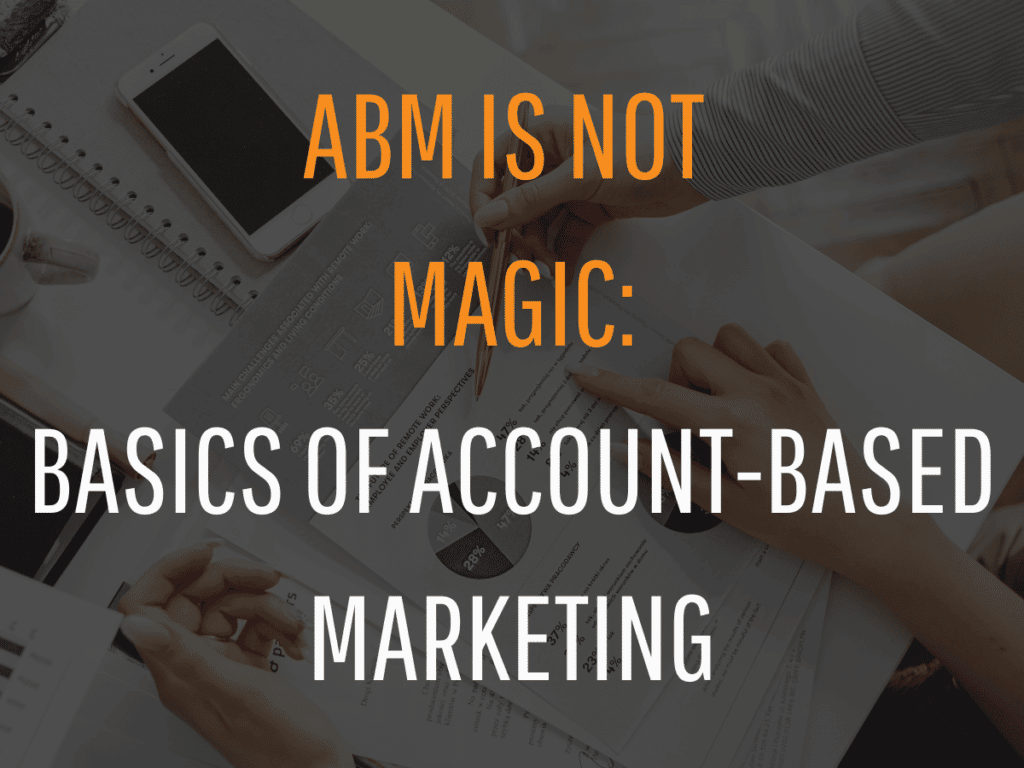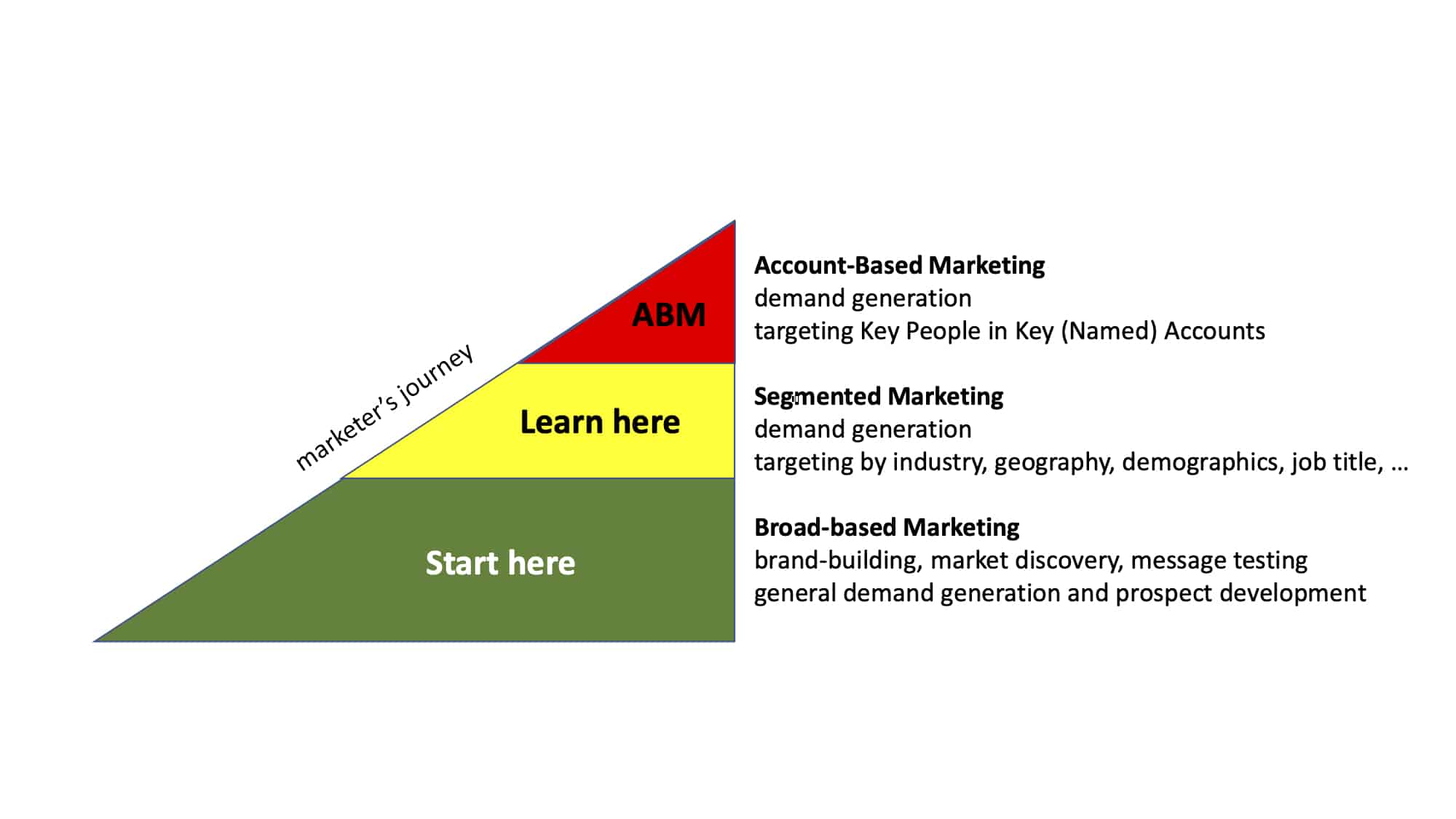What is Account-Based Marketing (ABM), and Should You Use It?
Lately, B2B demand generation marketing seems to be abuzz with lots of talk around account-based marketing (ABM). If you’ve been successfully nailing Account-Based Marketing for years, this piece is probably not for you. We put this together to demystify Account-Based Marketing (ABM) and help people get started.
Learn The Basics of ABM
Most B2B demand generation marketing is, to some extent, spray and pray. Through social media, email, paid media, LinkedIn, affiliate marketing, and other channels, we get “The Word” out in the “Right General Direction” and see who responds. When we find a successful combination of channels and messaging, we amp it up, do more, and keep spraying and praying. It works. Great companies have been built on this, and more great companies will continue to grow using this same approach to demand generation.
Account Based Marketing is the next step for some go-to-market strategies. It targets specific companies, usually enterprises of substance, with clear, focused messages, often tailored to each target company – and title within that company. First, you have to do the research to determine which companies you’re going after and learn what they think is important. Then, you have to find out who you want to target within each company. By name, with title, personal background, perhaps their executive assistant’s name, identify the buying committee and direct communications to them, personally. And marketing must work closely and honestly with the sales team to market – then sell – effectively with an account-based approach.
ABM is hard work: finding the right target companies, researching the correct people, and developing a set of targeted campaigns for each person at every target company takes time. Stakes go up. Costs go up. Innovation, cooperation, and creativity all need to accompany these efforts. And it’s worth it.
When ABM Makes Sense
You probably cannot and don’t want to do all ABM all the time. You’ll lose your mind. Coverage will not be comprehensive enough, and most technology companies I know of are always discovering where their current and next markets are. ABM targets the known, not the unknown prospective buyers.
So ABM is only part of your demand generation approach. You’ll likely have an industry-focused program, perhaps horizontal programs by job title, maybe by geography, too. These are tightened versions of spray-and-pray. They’re terrific for discovering new prospects and markets and are necessary for most companies’ market expansion.
You’ll generally reserve some minority percentage of your demand generation marketing budget for ABM – for targeting your large top prospects and cross-selling into existing, known accounts.
How To Start “Doing” ABM
As with most things in marketing, it starts with the customer. Find out WITH sales, not FROM sales, which major prospect companies you want to target with Account Based Marketing. Begin with a dozen or fewer. Five. Not too many to start. Agree that they’re all in your company’s strategy and worth going after.
Do your research on the companies and the leadership you are targeting. Total alignment with sales is critical here because you’re going to do a lot of work and spend resources on this. Work with sales to clearly understand what’s been done with these accounts and the people you believe you will target. Agree that all marketing and sales activity against these accounts and people will be planned and shared across teams.
Find previous successes that marketing and sales may have had with similar companies to your targets. Do this with sales. Learn what you can to shortcut your ABM learning and path to victory.
Then build your matrix of companies and targeted individuals showing channels and messages you want to use. Similar companies will have common messaging. Common titles will have similar messaging. Tune each message to the company and, where practical, to the individual. Use all available channels from email to direct mail to FedEx and beyond. These are high-value targets, but start with the least costly outreach (email, calling, LinkedIn) and ratchet up the ante as you see engagement.
Definition of Victory (DoV): Is Your ABM Campaign Successful?
Demand generation success is measured in revenue, period.
The next best thing is the pipeline value generated by sales from marketing activity. Lead flow means almost nothing if it doesn’t convert to pipeline value and revenue.
As you get ABM going, measure account coverage and account and individual engagement. Coverage is how many of the necessary buying team members we correctly identified in each target account. Engagement measures how many of those targeted people opened emails, answered phones, spoke with a salesperson, clicked on a link, or whatever you can measure that shows they’re reacting to your outreach.
You’ll make measurable progress by working closely with sales on your ABM programs and continuing to collaborate with the sales team as these programs are running – and the sales teams are doing their outreach and engagement. And when you’re not moving forward, adapt, change channels and messages, and renovate target accounts and people lists.
Technology Hurdles and Other Reasons to Delay ABM
Getting started with ABM is all about doing the work and aligning with sales. If salespeople aren’t buying into your ABM effort and actively collaborating with you, you may ask yourself why you’re even there. Marketing-and-sales is one word. Marketers cannot succeed without sales buy-in. It’s a fact of life. Acknowledge that fact and choose your path.
Many ABM technologies can help in the medium and long term. We’ll get to ABM-specific technology in another blog, perhaps. Everything we discussed today can and should be done in Salesforce or any decent CRM, Excel, or Sheets. Tools can help you scale. Waiting to bring in new tools as a precursor to ABM will delay you more than it will help you.
Keep It Simple. Keep It Updated. Keep Moving Forward.
You’ll end up working with a matrix of companies and people in those companies, charting your messages and interactions with each. The more you can simplify and generalize your messages and channels over time as you learn, the more you can scale. Start small. Work with sales. Get results. Simplify. Expand.
Marketing can show its value to sales by keeping on top of target companies and their key people. Do the ongoing research. Inform the teams of new insights, changes, and updates. Identify possible new ABM target accounts and people. Track sales activity in the accounts you are focused on. And every three months, renovate the target company list, take a few off, and add new ones. Ask sales to go after unresponsive prospects to see if they’re alive and interested. Work these target accounts.
Chameleon Collective serves its clients with global go-to-market strategy, insight, planning, and execution. With over 120 senior consultants in marketing, sales, and operations worldwide, we work with medium-sized companies and large enterprises in B2C, B2C, and everything in between.
At Chameleon, I provide Interim CEO, CMO, and B2B go-to-market guidance to fast-growing software firms. With global expertise as a software engineer, CMO, and CEO in public and PE-backed companies, I help accelerate revenue generation through process, alignment, understanding, and technology.
ABM can be a significant investment in time, and can help marketing-and-sales, one word, better align around high-value targets. Get started with good communications and sales collaboration, and you’ll see results. Ready to kickstart your ABM program? Send me a note at thor@chameleon.co.






